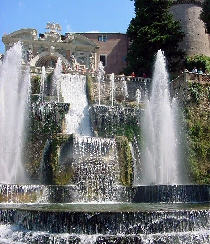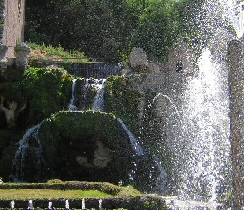A terrace was laid out in the south-west, supported by the old wall of the town.
Starting in 1560 great efforts were made to supply the water needed for the numerous fountains that were intended to embellish the garden. First, an aqueduct was built to capture the waters from Monte Sant’Angelo, but
this source of water turned out to be inadequate and so an underground canal (600 m.) was dug beneath the town to harness the waters of the Anio river. Once the water supply had been ensured and its flow made possible by the natural gravity created by the different levels of the garden, work started on
constructing the fountains, ornamental basins, and grottoes and on laying out the landscape.
During this period the old monastery was converted into
a villa and the original cloister was modified to become
the central courtyard, its south-east wall being that of the
old church of Santa Maria Maggiore. The pace of the
decoration work for the palace speeded up between 1565
and 1572, the year in which Cardinal Ippolito II d’Este
died.
Pirro Ligorio, Cardinal Ippolito II, and his secretary, the humanist Marc-Antoine Muret, designed the Villa d’Este according to a very elaborate iconography that celebrated the residence and Cardinal Ippolito II d’Este by magnifying his virtues and lineage. A statue of Hercules in the middle of the garden above the Fountain of the Dragons identifies the Tivoli garden with the mythological Garden of the Hesperides. According to 16th century historians, Hercules was the legendary ancestor of the Este family, but he was also one of the old
protective divinities of Tivoli.






